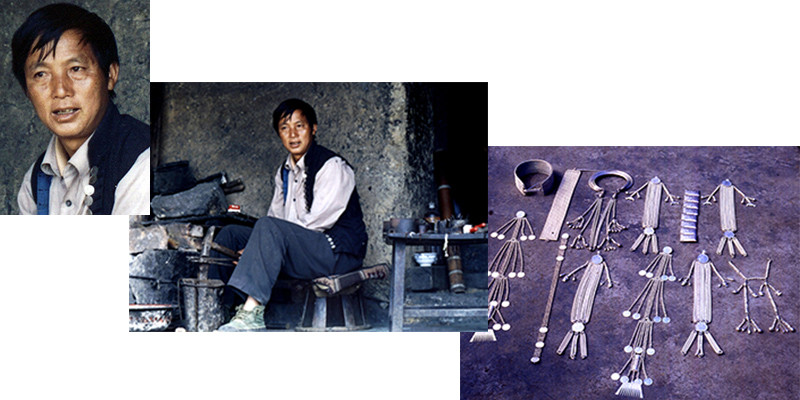
Zhao Wenliang – Inheritor of Yao Silver Ornament-making Craft in Jinping County, Honghe
Zhao Wenliang – Inheritor of Yao Silver Ornament-making Craft in Jinping County, Honghe
Nestled in Shui Duichong Village, Gantang Administrative Committee, Jinhe Town, Jinping County, Yunnan Province, Zhao Wenliang, a Yao ethnic craftsman in his 50s, has dedicated decades to preserving and perfecting the ancient art of Yao silver ornament craftsmanship. His story is one of passion, perseverance, and a deep commitment to passing down a cultural legacy steeped in history and symbolism.
The Artistry of Yao Silver Ornaments
Yao silver ornaments are more than adornments; they are a living archive of the Yao people’s history, beliefs, and aesthetic philosophy. Each piece—from intricate necklaces to ornate headdresses—embodies cultural narratives, featuring motifs inspired by nature (e.g., mountains, rivers, flora) and ancestral legends. Zhao Wenliang’s workshop, a humble space in his home, serves as both a studio and a shrine to this craft. Here, he transforms raw silver ingots into masterpieces through a meticulous process:
- Casting & Melting: Silver is heated to over 960°C until it liquefies, then poured into custom molds to form basic shapes.
- Hammering & Forging: Using a small, weighted hammer (weighing ~500g) and iron pliers, he beats silver strips into thin, flexible sheets—each necklace requires 6 such strips, each taking 3+ hours of continuous hammering (over 10,000 strikes).
- Braiding & Engraving: Delicate patterns are chiseled by hand, and components are woven into complex structures, often incorporating symbolic motifs like the “sun disc” or “tribal totem.”
- Polishing & Finishing: The final pieces are buffed with natural plant extracts to achieve a radiant, enduring shine.
Legacy of inheritance: Family and Community
Zhao Wenliang’s workshop is a family affair. His daughter-in-law, Zhao Fulan, has become his primary apprentice, mastering not only the technical skills but also the cultural stories behind each design. Together, they represent a rare intergenerational partnership in a craft often threatened by modernization:
- Domestic & Global Reach: While their clientele primarily includes local Yao communities in Jinping (who wear the ornaments during festivals, weddings, and religious rituals), their work has traveled beyond borders. Silver bracelets and hairpins, emblazoned with traditional Yao patterns, are now sold in ethnic minority markets in Kunming and exported to northern Vietnam, where Yao diaspora communities cherish them as cultural totems.
- Education & Outreach: Zhao Wenliang frequently opens his workshop to visitors, including university students and cultural researchers (e.g., the summer practice team from Shanghai University of Engineering Science). During these interactions, he demonstrates techniques, shares anecdotes about Yao silver’s role in tribal identity, and even offers short workshops for curious youth, though with limited success due to the craft’s labor-intensive nature.
Challenges and Commitment
Despite his dedication, Zhao faces daunting challenges:
- Time-Intensive Craft: A single ceremonial headdress, featuring dozens of interconnected silver bells and filigree patterns, can take up to two months to complete. Such meticulous work struggles to compete with mass-produced, cheaper alternatives.
- Generational Gap: Younger Yao individuals, drawn to urban opportunities, often view the craft as outdated. Zhao laments, “My hands remember every curve of the hammer, but where are the hands that will follow?”
- Cultural Preservation: With only a handful of master craftsmen left in Jinping, the survival of this 技艺 hinges on institutional support and community revitalization efforts.
A Guardian of Intangible Heritage
Zhao Wenliang’s work transcends craftsmanship; it is an act of cultural resistance. By 坚守 his workshop, training his family, and engaging with the outside world, he ensures that Yao silver ornamentation—with its spiritual symbolism and artistic precision—remains more than a relic of the past. As he often says, “Every silver thread I weave is a bridge between our ancestors and the future.”
In an era of rapid modernization, Zhao stands as a testament to the power of human hands to keep traditions alive, one hammer strike at a time. His story invites us to reflect: How do we honor the keepers of heritage who turn metal into memory?

http://www.ynich.cn/view-ml-13111-3296.html

 7 Days GolfingTour
7 Days GolfingTour
 8 Days Group Tour
8 Days Group Tour
 8 Days Yunnan Tour
8 Days Yunnan Tour
 7 Days Shangri La Hiking
7 Days Shangri La Hiking
 11 Days Yunnan Tour
11 Days Yunnan Tour
 6 Days Yuanyang Terraces
6 Days Yuanyang Terraces
 11 Days Yunnan Tour
11 Days Yunnan Tour
 8 Days South Yunnan
8 Days South Yunnan
 7 Days Tea Tour
7 Days Tea Tour
 8 Days Muslim Tour
8 Days Muslim Tour
 12 Days Self-Driving
12 Days Self-Driving
 4 Days Haba Climbing
4 Days Haba Climbing
 Tiger Leaping Gorge
Tiger Leaping Gorge
 Stone Forest
Stone Forest
 Yunnan-Tibet
Yunnan-Tibet
 Hani Rice Terraces
Hani Rice Terraces
 Kunming
Kunming
 Lijiang
Lijiang
 Shangri-la
Shangri-la
 Dali
Dali
 XishuangBanna
XishuangBanna
 Honghe
Honghe
 Kunming
Kunming
 Lijiang
Lijiang
 Shangri-la
Shangri-la
 Yuanyang Rice Terraces
Yuanyang Rice Terraces
 Nujiang
Nujiang
 XishuangBanna
XishuangBanna
 Spring City Golf
Spring City Golf
 Snow Mountain Golf
Snow Mountain Golf
 Stone Mountain Golf
Stone Mountain Golf

















